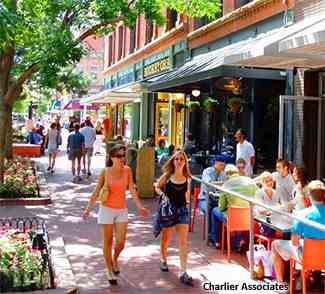A Greying New Jersey — The Housing Challenge
for Aging Baby Boomers
It may come as no surprise to Long Hill Township residents that New Jersey is the most unaffordable state in the country for senior citizens. Almost one-half of all New Jersey households headed by someone 65 or older are paying more than 30 percent of their gross household income on housing costs, as compared to only one-third of 65+ households nationally.

Through decades of Suburban Sprawl, New Jersey homeowners migrated to automobile-dependent residential clusters geographically removed from central cities. At the same time, commercial activity moved to equally automobile-dependent highway locations. As more residential developments were created, highways expanded, and the development cycle kept pushing outward. We are living now with the results of that demographic sprawl.
For older residents, the consequences for how and where we live now become a challenge as the physical impairments that come with age gradually erode their ability to drive – and hence their ability to accomplish many of their daily activities without assistance from others.
The Morris County Picture
Surprisingly, in Morris, Somerset and Middlesex counties, the housing cost burden is a notably bigger problem for older households than it is for the general population other counties.
Housing in these three counties is characterized by large single-family detached homes, often on large lots, that can be ill- suited to the lifestyle needs of older residents and also generally more expensive than smaller single-family homes or other housing options.
This pattern strongly suggests that the lack of smaller and less expensive housing options actually contributes to higher cost-burden rates for older homeowners.
55-Plus Communities: An Answer — But Not for Everyone
The growth of “55 plus” communities does offer an attractive option for many Baby Boomers, notably the opportunity to maintain an active lifestyle and normal life activities and remain engaged with other people their own age. But that option comes with limitations. In addition to a one-time initial buy-in fee for purchasing a residential unit, 55-plus communities typically charge between $2,000 and $5,000 a month for maintenance, upkeep and services, although some facilities may cost less.
Some seniors might feel uprooted from their own homes. They might not enjoy being surrounded by people their own age. Some residents might miss their friends at home and may find it difficult to make friends in a facility at which residents have already formed peer groups. For those who are used to living in their own homes, apartment-style facilities may prove uncomfortable.
Addressing the affordability problem for older people by building large self-contained complexes of age-restricted housing that are otherwise isolated in car-dependent environments may be an example of solving one problem by creating others.
The Walkable Neighborhood Alternative
A different option is provided in the concept of “walkable neighborhoods” in which residential development is mixed with neighborhood-serving commercial uses — ironically the same combination of uses that existed prior to the advent of Suburban Sprawl. For senior citizens, some important benefits of such a living arrangement typically include:
Manageability: Empty-nesters who no longer see the need for a large house on large parcels of land can live in a more manageable residence.
Age-appropriate Design: Housing built according to Universal Design principles can create residential units that are equally usable to the greatest extent possible by everyone, regardless of their age, ability, or status in life.

Affordability: Larger houses and properties generally have higher maintenance costs and property taxes than smaller houses. Smaller properties create affordable and accessible alternatives to multiple-acre housing lots, while reducing infrastructure and service costs for the municipality.
Accessibility: Smaller houses and apartments offer affordable and accessible alternatives, allowing individuals to remain in their communities following retirement. Housing located near existing development allows individuals to remain socially connected to their community less dependence on an automobile.
Safety: Older residents may feel safe knowing that neighbors can easily “check in” on one another.
Mix of uses: Putting different types of destinations (residential, employment, shopping) near each other means that multiple purposes can often be accomplished in a single trip, and that more types of trips can be taken by non-motorized means or by a shorter drive.
These are issues and choices the Master Plan Committee will be considering in the coming months. The concept of “walkable neighborhoods” as a realistic and desirable option for future development in parts of Long Hill Township is an important question for all of us to thoughtfully engage.
Data source: 2008-2012 American Community Survey 5-Year Estimates

